-
 Two volumes, 16.6 x 11.4 cm each, uniformly bound in sprinkled calf, spine with raised bands, gilt in compartments, with crimson and black gilt lettered labels. Ink inscription to title page of vol. 1: “Thomas Fry. St: John's, Oxford.” Vol. 1: Collation: 4to; π2 ✶2 a4 b3 A-Z4 2A-2E4 2F1, (total 124 leaves), plus frontispiece, 29 in-text vignettes. Pagination: [2] – h.t., [2] – t.p., [4] – preface, [i] ii-xiv – Vie de La Fontaine, [1] 2-224, [2] – table, (total 248 pages), ils. Vol. 2: Collation: 4to; π2 ✶3 A-Z4 2A-2K4 2L3, (total 140 leavs), 40 in-text vignettes. Pagination: [2] – h.t., [2] – t.p., [6] – preface, [1] 2-268, [2] – table, (total 280 pages), ils. Illustrations: frontispiece by Lebas (signature erased), Vie de La Fontaine headpiece by Fessard after Cochin, 2 fleurons on two title pages, 69 vignettes by Chedel, Fessard, and Ravenet after Cochin (not signed). Catalogue raisonné: Lewine: 278; Cohen-deRicci: 557-8. Contributors: Charles-Nicolas Cochin (French, 1715 – 1790) – artist. Engravers: Pierre Quentin Chedel (French, 1705 – 1763). Étienne Fessard (French, 1714 – 1774). Simon François Ravenet (French, 1706 – 1764). Jacques-Philippe Le Bas [Lebas] (French, 1707 – 1783). Provenance: Thomas Fry (British, 1718 – 1772) – English priest and academic, president of St John's College, Oxford from 1757.
Two volumes, 16.6 x 11.4 cm each, uniformly bound in sprinkled calf, spine with raised bands, gilt in compartments, with crimson and black gilt lettered labels. Ink inscription to title page of vol. 1: “Thomas Fry. St: John's, Oxford.” Vol. 1: Collation: 4to; π2 ✶2 a4 b3 A-Z4 2A-2E4 2F1, (total 124 leaves), plus frontispiece, 29 in-text vignettes. Pagination: [2] – h.t., [2] – t.p., [4] – preface, [i] ii-xiv – Vie de La Fontaine, [1] 2-224, [2] – table, (total 248 pages), ils. Vol. 2: Collation: 4to; π2 ✶3 A-Z4 2A-2K4 2L3, (total 140 leavs), 40 in-text vignettes. Pagination: [2] – h.t., [2] – t.p., [6] – preface, [1] 2-268, [2] – table, (total 280 pages), ils. Illustrations: frontispiece by Lebas (signature erased), Vie de La Fontaine headpiece by Fessard after Cochin, 2 fleurons on two title pages, 69 vignettes by Chedel, Fessard, and Ravenet after Cochin (not signed). Catalogue raisonné: Lewine: 278; Cohen-deRicci: 557-8. Contributors: Charles-Nicolas Cochin (French, 1715 – 1790) – artist. Engravers: Pierre Quentin Chedel (French, 1705 – 1763). Étienne Fessard (French, 1714 – 1774). Simon François Ravenet (French, 1706 – 1764). Jacques-Philippe Le Bas [Lebas] (French, 1707 – 1783). Provenance: Thomas Fry (British, 1718 – 1772) – English priest and academic, president of St John's College, Oxford from 1757. -
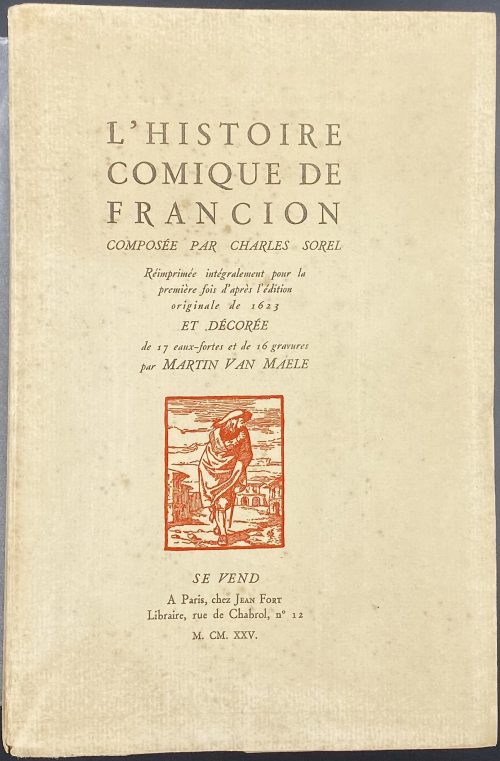 Description: One volume in cream French flapped wrappers, collated 8vo, 22.5 x 14.8 cm, lettered to front (device in red), printed on wove paper, margins untrimmed, some pages uncut, illustrated with tail- and headpieces and 17 sets of plates (4 of each plate) with tissue guards, after Martin van Maele. Front wrapper (red and black): L'HISTOIRE | COMIQUE DE | FRANCION | COMPOSÉE PAR CHARLES SOREL | Réimprimée intégralement pour la | première fois d'après l'édition | originale de 1623 | ET DÉCORÉE | de 17 eaux-fortes et de 16 gravures | par MARTIN VAN MAELE | {device} | SE VEND | A Paris, chez Jean Fort | Libraire, rue de Chabrol, no 12 | M. CM. XXV. || Title-page (red and black): L'HISTOIRE | COMIQUE DE | FRANCION | En laquelle sont découvertes les plus subtiles | finesses et trompeuses inventions tant des hommes | que des femmes de toutes sortes de conditions et | d’âges. Non moins profitable pour s’en | garder, que plaisante à la lecture. | Nouvelle édition conforme à | l’édition princeps de 1623, et | ornée de 17 eaux-fortes et | de 16 compositions par | MARTIN VAN MAELE | {device} | A PARIS | Chez Jean Fort, libraire, | Rue de Chabrol, no 12 | M. CM. XXV. || Collation: π3 (blank, h.t., t.p.), 1-268 χ3 (colophon, 2 blanks), total 214 leaves plus 17 sets of plates (4 of each). Pagination: [6] i-v [vi], 1-411 [412] [4], total 428 pages, ils. Illustrations: 16 tail- and headpieces, and one full-page vignette etched after drawings by Martin van Maële; 17 gravures coloured à la poupée after van Maële’s watercolours, each accompanied with three b/w plates in a different state of the same, incl. frontispiece; unpaginated. Limitation: The run of 1,203 copies printed on October 2, 1925, by Maurice Darantiere in Dijon; 1 copy (№ 1) on Japon Impérial is unique with the original drawings and three additional suites of plates; 10 copies (2-11) on Japon Impérial with three additional suites of plates; 31 copies (12-42) on Hollande with two additional suites of plates; 61 copies (43-103) on Madagascar with one additional suite of plates; 1,100 copies (104-1203) on Enoshima. This copy is № 10 on Japon Impérial with three additional suites of plates. Catalogue raisonné: S. A. Perry (2015) № 28, p. 31. Contributors: Charles Sorel, sieur de Souvigny (French, c. 1602 – 1674) – author Maurice François Alfred Martin van Maële [Martin van Maële] (French, 1863 – 1926) – artist. Maurice Darantiere (French, 1882 – 1962) – printer. Jean-Marie Fort (French, 20th century) – publisher.
Description: One volume in cream French flapped wrappers, collated 8vo, 22.5 x 14.8 cm, lettered to front (device in red), printed on wove paper, margins untrimmed, some pages uncut, illustrated with tail- and headpieces and 17 sets of plates (4 of each plate) with tissue guards, after Martin van Maele. Front wrapper (red and black): L'HISTOIRE | COMIQUE DE | FRANCION | COMPOSÉE PAR CHARLES SOREL | Réimprimée intégralement pour la | première fois d'après l'édition | originale de 1623 | ET DÉCORÉE | de 17 eaux-fortes et de 16 gravures | par MARTIN VAN MAELE | {device} | SE VEND | A Paris, chez Jean Fort | Libraire, rue de Chabrol, no 12 | M. CM. XXV. || Title-page (red and black): L'HISTOIRE | COMIQUE DE | FRANCION | En laquelle sont découvertes les plus subtiles | finesses et trompeuses inventions tant des hommes | que des femmes de toutes sortes de conditions et | d’âges. Non moins profitable pour s’en | garder, que plaisante à la lecture. | Nouvelle édition conforme à | l’édition princeps de 1623, et | ornée de 17 eaux-fortes et | de 16 compositions par | MARTIN VAN MAELE | {device} | A PARIS | Chez Jean Fort, libraire, | Rue de Chabrol, no 12 | M. CM. XXV. || Collation: π3 (blank, h.t., t.p.), 1-268 χ3 (colophon, 2 blanks), total 214 leaves plus 17 sets of plates (4 of each). Pagination: [6] i-v [vi], 1-411 [412] [4], total 428 pages, ils. Illustrations: 16 tail- and headpieces, and one full-page vignette etched after drawings by Martin van Maële; 17 gravures coloured à la poupée after van Maële’s watercolours, each accompanied with three b/w plates in a different state of the same, incl. frontispiece; unpaginated. Limitation: The run of 1,203 copies printed on October 2, 1925, by Maurice Darantiere in Dijon; 1 copy (№ 1) on Japon Impérial is unique with the original drawings and three additional suites of plates; 10 copies (2-11) on Japon Impérial with three additional suites of plates; 31 copies (12-42) on Hollande with two additional suites of plates; 61 copies (43-103) on Madagascar with one additional suite of plates; 1,100 copies (104-1203) on Enoshima. This copy is № 10 on Japon Impérial with three additional suites of plates. Catalogue raisonné: S. A. Perry (2015) № 28, p. 31. Contributors: Charles Sorel, sieur de Souvigny (French, c. 1602 – 1674) – author Maurice François Alfred Martin van Maële [Martin van Maële] (French, 1863 – 1926) – artist. Maurice Darantiere (French, 1882 – 1962) – printer. Jean-Marie Fort (French, 20th century) – publisher. -
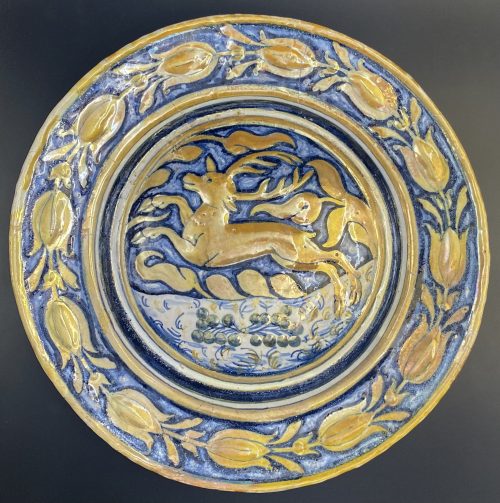 Tin-glazed earthenware plate with lustre in blue and ochre, decorated in relief with a deer in the centre and a chain of tulips on the lip; base signed “CK” in blue. Restored. Diameter: 24.8 cm; Height: 2.5 cm. Attributed to Gubbio (Umbria, Italy), 1520-1550.
Tin-glazed earthenware plate with lustre in blue and ochre, decorated in relief with a deer in the centre and a chain of tulips on the lip; base signed “CK” in blue. Restored. Diameter: 24.8 cm; Height: 2.5 cm. Attributed to Gubbio (Umbria, Italy), 1520-1550. -
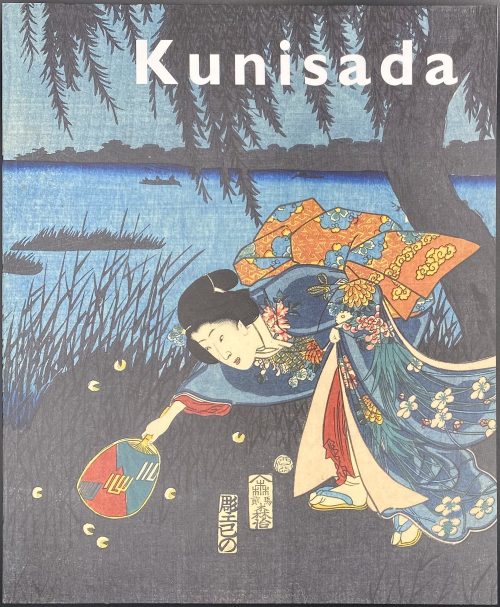 Softcover, publisher’s pictorial wrappers, 29.7 x 24.6 cm, pp.: [1-3] 4-174 [2 blank], ils.; total 88 leaves. Title-page: Kunisada | imaging | drama and beauty | Robert Schaap | with an introduction by Sebastian Izzard | and contributions by Paul Griffith and Henk. J. Herwig | {publisher’s device} Hotei Publishing || Contents: Preface / Robert Schaap & Chris Uhlenbeck; Lenders to the exhibition & catalogue: notes to readers; Utagawa Kunisada, the artist and his times / Sebastian Izzard; Catalogue / Robert Schaap with Paul Griffith, Henk J. Herwig & Sebastian Izzard. Subjects: Utagawa, Kunisada, — 1786-1864 — Catalogs; Color prints, Japanese — Edo period, 1600-1868 — Catalogs; Ukiyo-e — Catalogs. Contributors: Sebastian Izzard Paul Griffith Henk. J. Herwig Utagawa Kunisada [歌川 国貞] a.k.a. Utagawa Toyokuni III [三代歌川豊国] (Japanese, 1786 – 1865) Select illustrations (references in this collection):
Softcover, publisher’s pictorial wrappers, 29.7 x 24.6 cm, pp.: [1-3] 4-174 [2 blank], ils.; total 88 leaves. Title-page: Kunisada | imaging | drama and beauty | Robert Schaap | with an introduction by Sebastian Izzard | and contributions by Paul Griffith and Henk. J. Herwig | {publisher’s device} Hotei Publishing || Contents: Preface / Robert Schaap & Chris Uhlenbeck; Lenders to the exhibition & catalogue: notes to readers; Utagawa Kunisada, the artist and his times / Sebastian Izzard; Catalogue / Robert Schaap with Paul Griffith, Henk J. Herwig & Sebastian Izzard. Subjects: Utagawa, Kunisada, — 1786-1864 — Catalogs; Color prints, Japanese — Edo period, 1600-1868 — Catalogs; Ukiyo-e — Catalogs. Contributors: Sebastian Izzard Paul Griffith Henk. J. Herwig Utagawa Kunisada [歌川 国貞] a.k.a. Utagawa Toyokuni III [三代歌川豊国] (Japanese, 1786 – 1865) Select illustrations (references in this collection):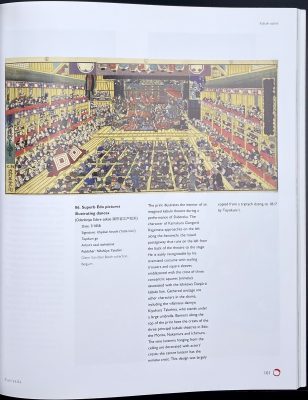
SVJP-0226.2016: Superb Edo pictures illustrating dances, 1858.
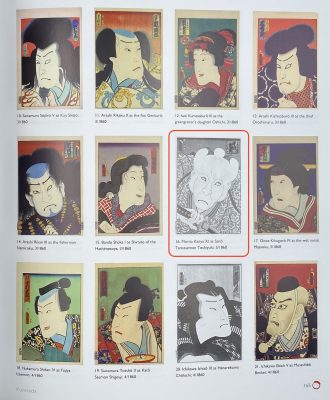
SVJP-0221.2016: Actor Morita Kan’ya XI as Saito Tarozaemon Toshiyuki, 1860.

SVJP-0228.2017: Matsumoto Kōshirō V (Japanese, 1764-1838) as Nikki Danjō Saemon Naonori, 1863.
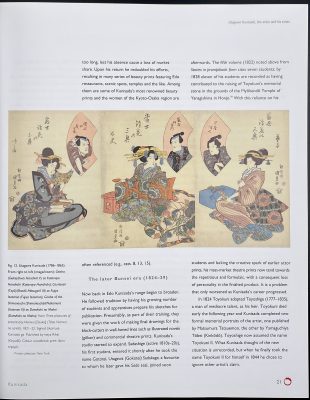
SVJP-0197.2015: Three Pleasures of Present-day Osaka (Tōsei Naniwa no sankō), 1821.
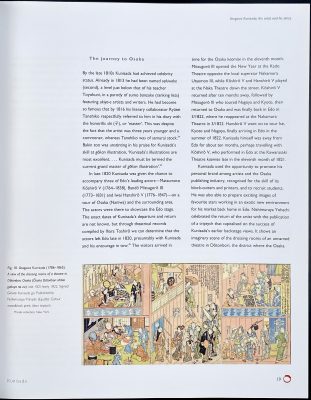
SVJP-0222.2016: A view of the dressing room of a Theater in Dōtonbori, Ōsaka, 1821-2.
-
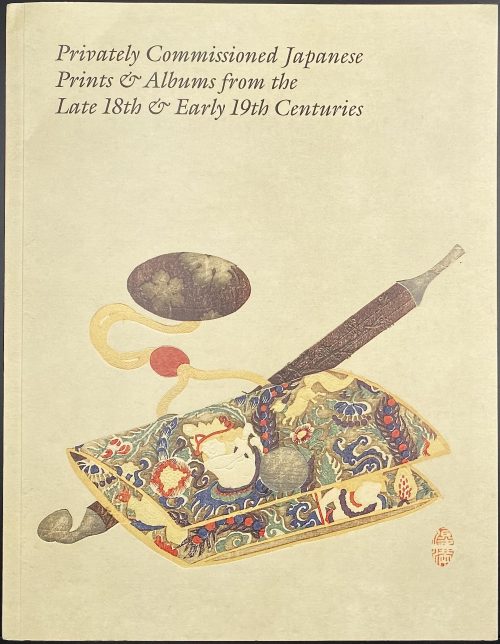 Softcover, in pictorial wrappers, 28 x 21.8 cm, 60 entries, with colour illustrations, some folding. Catalogue # 19 of the sales exhibition on March 18-26, 2022 in NY; pagination: [1-3] 4-149 [3], ils., some folding. Contributor: Sebastian Izzard
Softcover, in pictorial wrappers, 28 x 21.8 cm, 60 entries, with colour illustrations, some folding. Catalogue # 19 of the sales exhibition on March 18-26, 2022 in NY; pagination: [1-3] 4-149 [3], ils., some folding. Contributor: Sebastian Izzard -
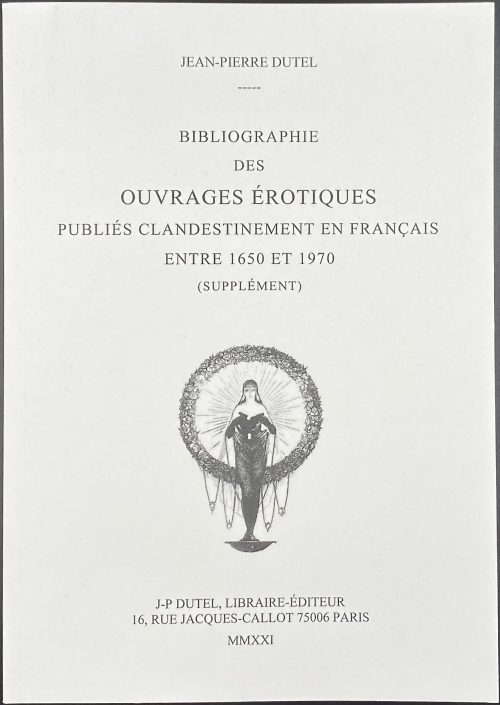 Description: Publisher’s wrappers 24 x 17 cm, pp. [1-6] 7-125 [3], total 64 leaves, edition limited to 150 copies. Includes “Errata & Addenda”, published in 2022. Cover and title-page: JEAN-PIERRE DUTEL | – | BIBLIOGRAPHIE | DES | OUVRAGES ÉROTIQUES | PUBLIÉS CLANDESTINEMENT EN FRANÇAIS | ENTRE 1650 ET 1970 (SUPPLÉMENT) | {publisher’s device} | J-P DUTEL, LIBRAIRE-ÉDITEUR | 16, RUE JACQUES-CALLOT 75006 PARIS | MMXXI ||
Description: Publisher’s wrappers 24 x 17 cm, pp. [1-6] 7-125 [3], total 64 leaves, edition limited to 150 copies. Includes “Errata & Addenda”, published in 2022. Cover and title-page: JEAN-PIERRE DUTEL | – | BIBLIOGRAPHIE | DES | OUVRAGES ÉROTIQUES | PUBLIÉS CLANDESTINEMENT EN FRANÇAIS | ENTRE 1650 ET 1970 (SUPPLÉMENT) | {publisher’s device} | J-P DUTEL, LIBRAIRE-ÉDITEUR | 16, RUE JACQUES-CALLOT 75006 PARIS | MMXXI || -
 Artist: Utagawa Kuniyoshi [歌川 國芳] (Japanese, 1798 – 1861). Publisher: Izuzen (fl. c. 1800s – 1840s) (Marks 06-029|U103b). Signed: Ichiyosai Kuniyoshi ga in a red cartouche and sealed with paulownia crest (kiri mon). Double nanushi censor seals: Fuku & Muramatsu, 1849-51 (Kaei 2 – Kaei 4). Young woman in front of the western-style framed portrait of Soga Tokimune, who is depicted after having his kusazuri ripped off by Asahina Saburō. The series of fan prints A Collection of Pictures in Modern Style [今様額面合] (Imayô gakumen awase) can be found at Kuniyoshi Project. Soga Tokimune, a.k.a. Soga no Gorō [曾我時致] (Japanese, 1174 – 1193), a historical figure and a character of an epic tale Soga Monogatari [曽我物語] (A Tale of Soga Brothers). Asahina Saburō [朝比奈 三朗], a.k.a. Asahina Yoshihide [朝比奈 義秀] is also mentioned in the Soga Monogatari. Kusazuri [草摺] (くさずり) – tassets on a suit of a samurai's armour. Another Kuniyoshi's print with the same characters: Goro Tokimune and Asahina Saburo; Series: The Tale of Soga Brothers; Publisher: Ibaya Senzaburō; Date: 1843-1845; Size: Vertical Ōban: 359 x 245 mm.
Artist: Utagawa Kuniyoshi [歌川 國芳] (Japanese, 1798 – 1861). Publisher: Izuzen (fl. c. 1800s – 1840s) (Marks 06-029|U103b). Signed: Ichiyosai Kuniyoshi ga in a red cartouche and sealed with paulownia crest (kiri mon). Double nanushi censor seals: Fuku & Muramatsu, 1849-51 (Kaei 2 – Kaei 4). Young woman in front of the western-style framed portrait of Soga Tokimune, who is depicted after having his kusazuri ripped off by Asahina Saburō. The series of fan prints A Collection of Pictures in Modern Style [今様額面合] (Imayô gakumen awase) can be found at Kuniyoshi Project. Soga Tokimune, a.k.a. Soga no Gorō [曾我時致] (Japanese, 1174 – 1193), a historical figure and a character of an epic tale Soga Monogatari [曽我物語] (A Tale of Soga Brothers). Asahina Saburō [朝比奈 三朗], a.k.a. Asahina Yoshihide [朝比奈 義秀] is also mentioned in the Soga Monogatari. Kusazuri [草摺] (くさずり) – tassets on a suit of a samurai's armour. Another Kuniyoshi's print with the same characters: Goro Tokimune and Asahina Saburo; Series: The Tale of Soga Brothers; Publisher: Ibaya Senzaburō; Date: 1843-1845; Size: Vertical Ōban: 359 x 245 mm.
-
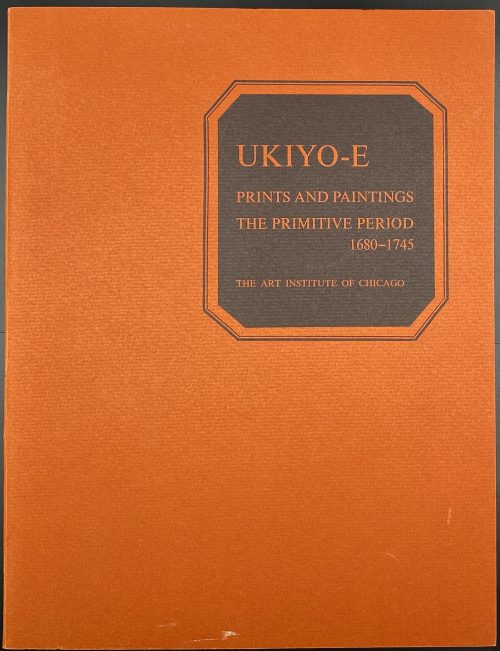 Description: exhibition catalogue, softcover terra-cotta paper with lettered black label to front and black lettering to spine, black endpapers; pp.: [1-6] 7-131 [132] plus colour frontispiece and 5 colour plates outside pagination, 190 entries with b/w in-text illustrations. Front cover (in the octagonal black label): UKIYO-E | PRINTS AND PAINTINGS | THE PRIMITIVE PERIOD | 1680–1745 | THE ART INSTITUTE OF CHICAGO || Title-page: THE ART INSTITUTE OF CHICAGO | UKIYO-E PRINTS AND PAINTINGS | THE PRIMITIVE PERIOD, 1680–1745 | An Exhibition in Memory of Margaret O. Gentles | November 6th–December 26th, 1971 | Catalogue by DONALD JENKINS || Foreword by Charles C. Cunningham, Tribute to Margaret O. Gentles by Jack V. Sewell. Contributors: Margaret O. Gentles (American, 1905 – 1969) Donald John Jenkins (American, b. 1931) Charles Crehore Cunningham (American, 1910 – 1979) Jack V. Sewell (American, 1923 – 2010)
Description: exhibition catalogue, softcover terra-cotta paper with lettered black label to front and black lettering to spine, black endpapers; pp.: [1-6] 7-131 [132] plus colour frontispiece and 5 colour plates outside pagination, 190 entries with b/w in-text illustrations. Front cover (in the octagonal black label): UKIYO-E | PRINTS AND PAINTINGS | THE PRIMITIVE PERIOD | 1680–1745 | THE ART INSTITUTE OF CHICAGO || Title-page: THE ART INSTITUTE OF CHICAGO | UKIYO-E PRINTS AND PAINTINGS | THE PRIMITIVE PERIOD, 1680–1745 | An Exhibition in Memory of Margaret O. Gentles | November 6th–December 26th, 1971 | Catalogue by DONALD JENKINS || Foreword by Charles C. Cunningham, Tribute to Margaret O. Gentles by Jack V. Sewell. Contributors: Margaret O. Gentles (American, 1905 – 1969) Donald John Jenkins (American, b. 1931) Charles Crehore Cunningham (American, 1910 – 1979) Jack V. Sewell (American, 1923 – 2010) -
 A shakudō kozuka decorated with equestrian tack inlaid in raven black shakudō, gold uttori and a silver alloy on a nanako ground. Unsigned. Attributed to Goto Joshin (Japanese, 1513 – 1562), 3rd generation Goto master. Late Muromachi period, Tenbun era (c. 1550). Size: 96.7 x 14.4 x 4.9 mm. Tokubetsu Hozon certificate № 2004230 issued by NBTHK on May 10, 2017. For a detailed explanation of terms see: Sesko, Markus. Handbook: Of Sword Fittings Related Terms. Germany: Books on Demand, 2011.
A shakudō kozuka decorated with equestrian tack inlaid in raven black shakudō, gold uttori and a silver alloy on a nanako ground. Unsigned. Attributed to Goto Joshin (Japanese, 1513 – 1562), 3rd generation Goto master. Late Muromachi period, Tenbun era (c. 1550). Size: 96.7 x 14.4 x 4.9 mm. Tokubetsu Hozon certificate № 2004230 issued by NBTHK on May 10, 2017. For a detailed explanation of terms see: Sesko, Markus. Handbook: Of Sword Fittings Related Terms. Germany: Books on Demand, 2011. -
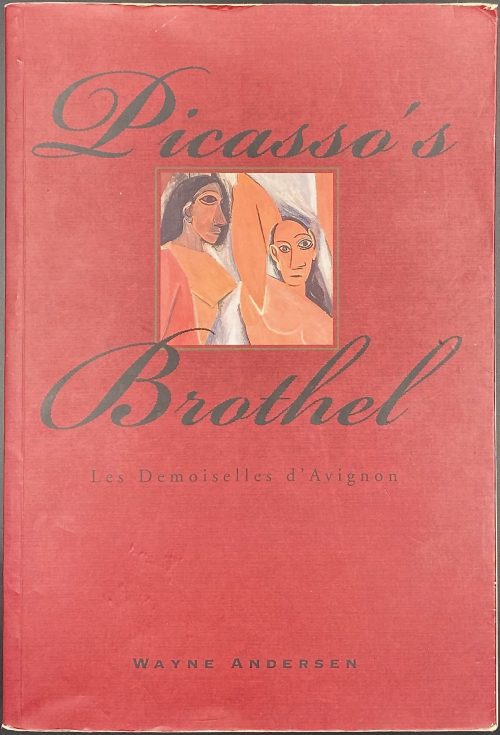 Paperback, 25.3 x 17.3 cm, burgundy flapped wrappers, pp.: [i-vii] viii-x, [2] [1] 2-356. Front wrapper: Picasso's | {vignette} | Brothel | Les Demoiselles d'Avignon | Wayne Andersen || Title-page: PICASSO'S BROTHEL | LES DEMOISELLES D'AVIGNON | — | WAYNE ANDERSEN | {publisher’s device} | Other Press | New York || Wayne Andersen (American, 1928 – 2014) Pablo Picasso (Spanish, 1881 – 1973) Les Demoiselles d'Avignon
Paperback, 25.3 x 17.3 cm, burgundy flapped wrappers, pp.: [i-vii] viii-x, [2] [1] 2-356. Front wrapper: Picasso's | {vignette} | Brothel | Les Demoiselles d'Avignon | Wayne Andersen || Title-page: PICASSO'S BROTHEL | LES DEMOISELLES D'AVIGNON | — | WAYNE ANDERSEN | {publisher’s device} | Other Press | New York || Wayne Andersen (American, 1928 – 2014) Pablo Picasso (Spanish, 1881 – 1973) Les Demoiselles d'Avignon -
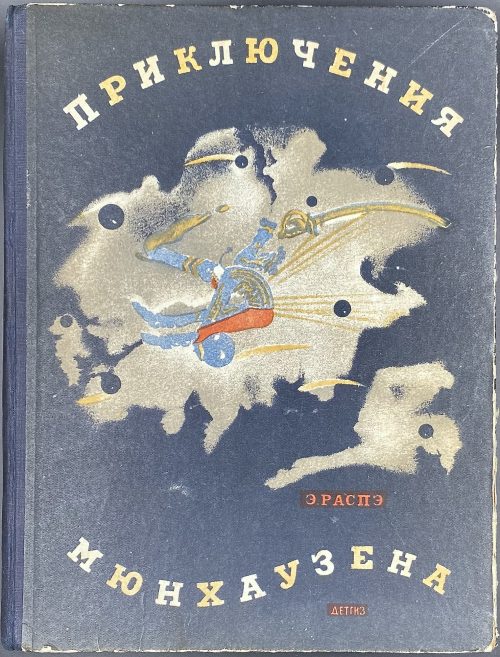 Hardcover, 26.2 x 20.3 cm, quarter blue cloth over pictorial boards, pictorial endpapers, collated in-8vo, 1-58 64, pp.: [2] 3-87 [88], total 44 leaves with in-text woodcuts plus 8 leaves of colour plates (14 illustrations printed on both sides) and colour frontispiece (blank recto) after Gustave Doré. The story was written by Rudolf Erich Raspe in English and published anonymously in book form in Oxford in 1786 under the title Baron Munchausen's Narrative of his marvellous travels and campaigns in Russia, etc. The French translation from German of Gottfried August Bürger was performed by Théophile Gautier and published by Charles Furne in Paris in 1862 with illustrations after Gustave Doré – 158 wood engravings, including a frontispiece, 1 vignette on the title, 31 full-page plates and 125 vignettes in the text). Korney Chukovsky retold the Raspe story in Russian using the Būrger-Gautier version of the text, changing the order, time, and location of events. In addition, artist Yuri Syrnev (Ю. А. Сырнев) coloured Dore's woodcuts, and the book was born (first edition in 1928). Title-page (black and yellow earth): Э. РАСПЭ | ПРИКЛЮЧЕНИЯ | {vignette} | МЮНХАУЗЕНА | С ИЛЛЮСТРАЦИЯМИ | ГУСТАВА | ДОРЭ | • | ДЛЯ | ДЕТЕЙ | ПЕРЕСКАЗАЛ К.ЧУКОВСКИЙ | • | ГОСУДАРСТВЕННОЕ ИЗДАТЕЛЬСТВО ДЕТСКОЙ ЛИТЕРАТУРЫ | НАРКОМПРОСА РСФСР | Москва 1945 Ленинград || Colophon: Для младшего возраста | РАСКРАСКА ВКЛЕЕК, ТИТУЛ И ОБЛОЖКА | худ. Ю. Сырнева | Издание десятое || Edition: 10th Russian edition thus. Print run: 11,000 copies. Contributors: Rudolf Erich Raspe (German, 1736 – 1794) – author. Korney Chukovsky [Корней Иванович Чуковский, Николай Корнейчуков] (Russian, 1882 – 1969) – translator. Gustave Doré (French, 1832 – 1883) – artist. Юрий Аркадьевич Сырнев (Russian, 1905 – 1943) – artist. Fictional author: Baron Munchausen [Baron Münchhausen] / Karl Friedrich Hieronymus von Münchhausen (German, 1720 – 1797).
Hardcover, 26.2 x 20.3 cm, quarter blue cloth over pictorial boards, pictorial endpapers, collated in-8vo, 1-58 64, pp.: [2] 3-87 [88], total 44 leaves with in-text woodcuts plus 8 leaves of colour plates (14 illustrations printed on both sides) and colour frontispiece (blank recto) after Gustave Doré. The story was written by Rudolf Erich Raspe in English and published anonymously in book form in Oxford in 1786 under the title Baron Munchausen's Narrative of his marvellous travels and campaigns in Russia, etc. The French translation from German of Gottfried August Bürger was performed by Théophile Gautier and published by Charles Furne in Paris in 1862 with illustrations after Gustave Doré – 158 wood engravings, including a frontispiece, 1 vignette on the title, 31 full-page plates and 125 vignettes in the text). Korney Chukovsky retold the Raspe story in Russian using the Būrger-Gautier version of the text, changing the order, time, and location of events. In addition, artist Yuri Syrnev (Ю. А. Сырнев) coloured Dore's woodcuts, and the book was born (first edition in 1928). Title-page (black and yellow earth): Э. РАСПЭ | ПРИКЛЮЧЕНИЯ | {vignette} | МЮНХАУЗЕНА | С ИЛЛЮСТРАЦИЯМИ | ГУСТАВА | ДОРЭ | • | ДЛЯ | ДЕТЕЙ | ПЕРЕСКАЗАЛ К.ЧУКОВСКИЙ | • | ГОСУДАРСТВЕННОЕ ИЗДАТЕЛЬСТВО ДЕТСКОЙ ЛИТЕРАТУРЫ | НАРКОМПРОСА РСФСР | Москва 1945 Ленинград || Colophon: Для младшего возраста | РАСКРАСКА ВКЛЕЕК, ТИТУЛ И ОБЛОЖКА | худ. Ю. Сырнева | Издание десятое || Edition: 10th Russian edition thus. Print run: 11,000 copies. Contributors: Rudolf Erich Raspe (German, 1736 – 1794) – author. Korney Chukovsky [Корней Иванович Чуковский, Николай Корнейчуков] (Russian, 1882 – 1969) – translator. Gustave Doré (French, 1832 – 1883) – artist. Юрий Аркадьевич Сырнев (Russian, 1905 – 1943) – artist. Fictional author: Baron Munchausen [Baron Münchhausen] / Karl Friedrich Hieronymus von Münchhausen (German, 1720 – 1797). -
 Two volumes in-12, 16.8 x 11.5 cm each, uniformly bound in ¾ red crushed morocco over marbled boards, spine with raised bands and gilt lettering, marbled endpapers, text printed on laid paper, 6 plates (3 in each vol.) on India paper pasted in on thick laid paper leaves. This edition seems similar to Nordmann I 203 but without Félicien Rops' frontispiece and plates, replaced by unsigned etchings attributed to Gustave Staal. Title-page (red and black): LE RICHE DE LA POPELINIÈRE | – | TABLEAUX | DES | MŒURS DU TEMPS | DANS LES DIFFÉRENTS AGES DE LA VIE | – | NOTICE DE | CHARLES MONSELET | – | TOME PREMIER (SECOND) | {fleuron} | PARIS | IMPRIMERIE DES CI-DEVANT FERMIERS GÉNÉRAUX | – | M D CCC L XVII || Vol. 1: π2 (h.t., t.p.) a4 (Notice), 1-1312 151 (Table); total 91 leaves plus three leaves of plates. Pagination: [4] [i] ii-vii [viii] [3] 4-168 [2]; total 182 pp, ils. facing pp. 59, 78, and 94. Vol. 2: π2 (h.t., t.p.), 1-1312, 152; total 88 leaves plus three leaves of plates. Pagination: [4] [1] 2-170 [2]; total 176 pp, ils. facing pp. 74, 78, and 145. Catalogue raisonné: Dutel I: A-1044 — without Félicien Rops ‘ornementations’, but with ‘6 gravures de 1865’. Dutel suggests that the edition was performed by A. Poulet-Malassis, Briard or Lécrivain. Catalogue Poulet-Malassis & ses amis description: № 43. LE RICHE DE LA POPELINIÈRE. Tableaux des mœurs du temps dans les diérents âges de la vie, tome premier (— second). Notice de M. Charles Monselet. Imprimerie des ci-devant fermiers généraux, Paris, M D CCC LXVII [A. Poulet-Malassis, 1867]. Exemplaire sans le frontispice de Félicien Rops mais bien complet des 6 figures de Staal, justification qui illustre les aléas de la confection des publications clandestines. D’une part, c’est une autre édition qui est décrite par Launay. L’exemplaire vendu chez Maître Loudmer avait 6 figures, comme ici. Cluzel a vu un “front. et 4 vignettes de Rops plus cinq figures libres (par Staal)”, Simonson a vu 5 figures de Rops, etc., etc. Il y a 3 bandeaux et 3 culs-de-lampe de Rops qui ont été fréquemment utilisés par d’autres éditeurs pour d’autres titres pendant toute la seconde moitié du xixe siècle. La Léonina présente une fiche détaillée sur 4 pages. 3 bandeaux et 3 culs-de-lampe gravés sur bois de Rops. Bibliographie : Pia 1389, Launay 327, Gay 6-308, Pey 122 (1800 frs avec 5 figures), PC 503 et 504, Lemonnyer 3-1173, LL 66, Leonina 81, Nordmann 1-203, Dutel A-1043. Contributors: Alexandre Jean Joseph Le Riche de La Popelinière (French, 1693 – 1762) – author. Charles Monselet (French, 1825 – 1888) – author (foreword). Pierre-Gustave-Eugène Staal (French, 1817 – 1882) – artist. Auguste Poulet-Malassis (French, 1825 – 1878) – publisher.
Two volumes in-12, 16.8 x 11.5 cm each, uniformly bound in ¾ red crushed morocco over marbled boards, spine with raised bands and gilt lettering, marbled endpapers, text printed on laid paper, 6 plates (3 in each vol.) on India paper pasted in on thick laid paper leaves. This edition seems similar to Nordmann I 203 but without Félicien Rops' frontispiece and plates, replaced by unsigned etchings attributed to Gustave Staal. Title-page (red and black): LE RICHE DE LA POPELINIÈRE | – | TABLEAUX | DES | MŒURS DU TEMPS | DANS LES DIFFÉRENTS AGES DE LA VIE | – | NOTICE DE | CHARLES MONSELET | – | TOME PREMIER (SECOND) | {fleuron} | PARIS | IMPRIMERIE DES CI-DEVANT FERMIERS GÉNÉRAUX | – | M D CCC L XVII || Vol. 1: π2 (h.t., t.p.) a4 (Notice), 1-1312 151 (Table); total 91 leaves plus three leaves of plates. Pagination: [4] [i] ii-vii [viii] [3] 4-168 [2]; total 182 pp, ils. facing pp. 59, 78, and 94. Vol. 2: π2 (h.t., t.p.), 1-1312, 152; total 88 leaves plus three leaves of plates. Pagination: [4] [1] 2-170 [2]; total 176 pp, ils. facing pp. 74, 78, and 145. Catalogue raisonné: Dutel I: A-1044 — without Félicien Rops ‘ornementations’, but with ‘6 gravures de 1865’. Dutel suggests that the edition was performed by A. Poulet-Malassis, Briard or Lécrivain. Catalogue Poulet-Malassis & ses amis description: № 43. LE RICHE DE LA POPELINIÈRE. Tableaux des mœurs du temps dans les diérents âges de la vie, tome premier (— second). Notice de M. Charles Monselet. Imprimerie des ci-devant fermiers généraux, Paris, M D CCC LXVII [A. Poulet-Malassis, 1867]. Exemplaire sans le frontispice de Félicien Rops mais bien complet des 6 figures de Staal, justification qui illustre les aléas de la confection des publications clandestines. D’une part, c’est une autre édition qui est décrite par Launay. L’exemplaire vendu chez Maître Loudmer avait 6 figures, comme ici. Cluzel a vu un “front. et 4 vignettes de Rops plus cinq figures libres (par Staal)”, Simonson a vu 5 figures de Rops, etc., etc. Il y a 3 bandeaux et 3 culs-de-lampe de Rops qui ont été fréquemment utilisés par d’autres éditeurs pour d’autres titres pendant toute la seconde moitié du xixe siècle. La Léonina présente une fiche détaillée sur 4 pages. 3 bandeaux et 3 culs-de-lampe gravés sur bois de Rops. Bibliographie : Pia 1389, Launay 327, Gay 6-308, Pey 122 (1800 frs avec 5 figures), PC 503 et 504, Lemonnyer 3-1173, LL 66, Leonina 81, Nordmann 1-203, Dutel A-1043. Contributors: Alexandre Jean Joseph Le Riche de La Popelinière (French, 1693 – 1762) – author. Charles Monselet (French, 1825 – 1888) – author (foreword). Pierre-Gustave-Eugène Staal (French, 1817 – 1882) – artist. Auguste Poulet-Malassis (French, 1825 – 1878) – publisher. -
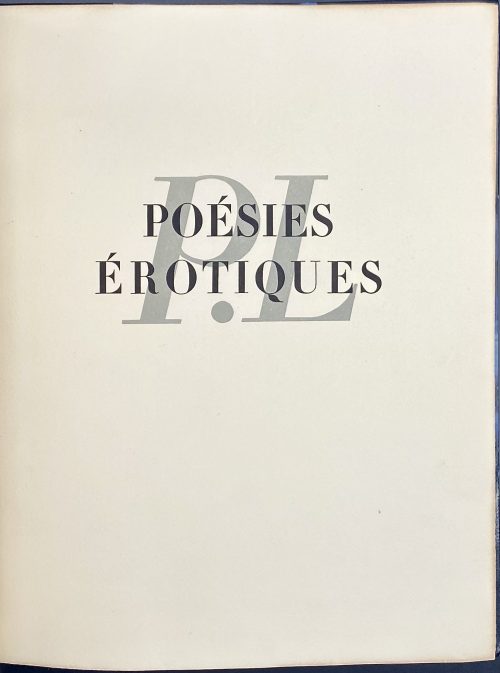 Hardcover volume, 26.6 x 21.3 cm, ¾ blue crushed morocco over marbled boards, marbled endpapers, original wrappers preserved, raised bands; wove paper, watermarked Van Gelder Zonen, unpaginated, 2 ffl, 1 front cover, 2 blanks, 1 h.t., 1 t.p., 46 leaves of text and plates (18 full-page and 14 half-page lithographs by Marcel Vertès), 1 colophon, 1 blank, 1 back cover, 2 ffl; 52 leaves within the original covers, as per Dutel. Title-page: POÉSIES | ÉROTIQUES | D' | UN | AUTE | UR CÉ | LÈBRE, | ILLUSTRÉ | ES DE TR | ENTE-DEUX | LITHOGRAPHIES | ORIGINALES | DESSINÉES | PAR UN | ARTISTE | INCON | NU | ★ | BARCELONE | ATARAZANAS (BARRIO CHINO) | L'AN I DE LA RÉPUBLIQUE | CATALANE || Limitation: A print run of 165 numbered copies, of which this is copy № 148, and 5 additional presentation copies. The text was printed by Massol, and plates were produced by Mme Duchatel. Catalogue raisonné: Dutel III № 2228 ; Nordmann II (Christie’s) № 321; Éros invaincu № 92, p. 222; Vokaer № 36, p. 16. Contributors: Pierre Louÿs (French, 1870 – 1925) – author. Marcel Vertès [Marcell Vértes] (Jewish-Hungarian-French, 1895 – 1961) – artist. René Bonnel (French, 1884 – 1975) – publisher.
Hardcover volume, 26.6 x 21.3 cm, ¾ blue crushed morocco over marbled boards, marbled endpapers, original wrappers preserved, raised bands; wove paper, watermarked Van Gelder Zonen, unpaginated, 2 ffl, 1 front cover, 2 blanks, 1 h.t., 1 t.p., 46 leaves of text and plates (18 full-page and 14 half-page lithographs by Marcel Vertès), 1 colophon, 1 blank, 1 back cover, 2 ffl; 52 leaves within the original covers, as per Dutel. Title-page: POÉSIES | ÉROTIQUES | D' | UN | AUTE | UR CÉ | LÈBRE, | ILLUSTRÉ | ES DE TR | ENTE-DEUX | LITHOGRAPHIES | ORIGINALES | DESSINÉES | PAR UN | ARTISTE | INCON | NU | ★ | BARCELONE | ATARAZANAS (BARRIO CHINO) | L'AN I DE LA RÉPUBLIQUE | CATALANE || Limitation: A print run of 165 numbered copies, of which this is copy № 148, and 5 additional presentation copies. The text was printed by Massol, and plates were produced by Mme Duchatel. Catalogue raisonné: Dutel III № 2228 ; Nordmann II (Christie’s) № 321; Éros invaincu № 92, p. 222; Vokaer № 36, p. 16. Contributors: Pierre Louÿs (French, 1870 – 1925) – author. Marcel Vertès [Marcell Vértes] (Jewish-Hungarian-French, 1895 – 1961) – artist. René Bonnel (French, 1884 – 1975) – publisher. -
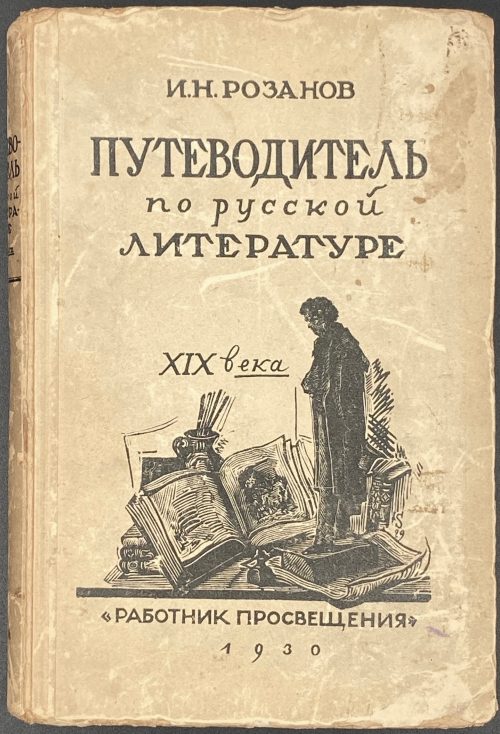 Hardcover, 17 x 12 cm, tan paper over cardboard, black lettering and vignette to front cover "И. Н. РОЗАНОВ | ПУТЕВОДИТЕЛЬ | по русской | ЛИТЕРАТУРЕ | XIX века | {vignette} | «РАБОТНИК ПРОСВЕЩЕНИЯ» | 1930", design of the cover by А. Суворов (woodcut), lettering to spine. Blue ink oval stamp “Из КНИГ | Д.С.НЕСТЕРОВ | и | ЖУРНАЛОВ”. Collation/pagination: 8vo: 1-218, total 168 leaves; pp.: [1-8] 9-336. Title-page: Double rule | Путеводитель | по русской | литературе | XIX века СОСТАВИЛ ИВ. РОЗАНОВ ИЗДАНИЕ ТРЕТЬЕ | РАБОТНИК ПРОСВЕЩЕНИЯ | МОСКВА – 1930 – ЛЕНИНГРАД || Print run: 5,100 copies. Contributors: Иван Никанорович Розанов (Russian, 1874 – 1959) Анатолий Андреевич Суворов (Russian, 1890—1943)
Hardcover, 17 x 12 cm, tan paper over cardboard, black lettering and vignette to front cover "И. Н. РОЗАНОВ | ПУТЕВОДИТЕЛЬ | по русской | ЛИТЕРАТУРЕ | XIX века | {vignette} | «РАБОТНИК ПРОСВЕЩЕНИЯ» | 1930", design of the cover by А. Суворов (woodcut), lettering to spine. Blue ink oval stamp “Из КНИГ | Д.С.НЕСТЕРОВ | и | ЖУРНАЛОВ”. Collation/pagination: 8vo: 1-218, total 168 leaves; pp.: [1-8] 9-336. Title-page: Double rule | Путеводитель | по русской | литературе | XIX века СОСТАВИЛ ИВ. РОЗАНОВ ИЗДАНИЕ ТРЕТЬЕ | РАБОТНИК ПРОСВЕЩЕНИЯ | МОСКВА – 1930 – ЛЕНИНГРАД || Print run: 5,100 copies. Contributors: Иван Никанорович Розанов (Russian, 1874 – 1959) Анатолий Андреевич Суворов (Russian, 1890—1943) -
 Iron tsuba of almost round form with a brass outlined circular opening (sukashi) in the bottom adorned with the Myriad Treasures [takaramono, 宝物] and winter motifs inlaid in cast brass (suemon-zōgan); hitsu-ana possibly cut later, both plugged with shakudo, nakaga-ana fitted with copper sekigane. According to Merrily Baird*) (2001), the symbolism of Myriad Treasures “is associated with the Seven Gods of Good Luck, who carry them in a sack”. Among the treasures, which are said to ensure prosperity, long life, and general good fortunes, are (reading clockwise from the top):
Iron tsuba of almost round form with a brass outlined circular opening (sukashi) in the bottom adorned with the Myriad Treasures [takaramono, 宝物] and winter motifs inlaid in cast brass (suemon-zōgan); hitsu-ana possibly cut later, both plugged with shakudo, nakaga-ana fitted with copper sekigane. According to Merrily Baird*) (2001), the symbolism of Myriad Treasures “is associated with the Seven Gods of Good Luck, who carry them in a sack”. Among the treasures, which are said to ensure prosperity, long life, and general good fortunes, are (reading clockwise from the top):- Sake set [shuki, 酒器], namely flask, ladle, and cups
- Cloves [choji, 丁子]
- Purse of inexhaustible reaches [kinchaku, 巾着]
- Magic mallet [kozuchi, 小槌]
- Key to the storehouse of the Gods [kagi, 鍵]
- Rhombus, or Lozenge (hosho, 方勝), with the second ideograph meaning victory.
- Sacred (or wish-granting) gem, or jewel [hōju, 宝珠]
- Hats of invisibility [kakuregasa, 隠れ笠]
-
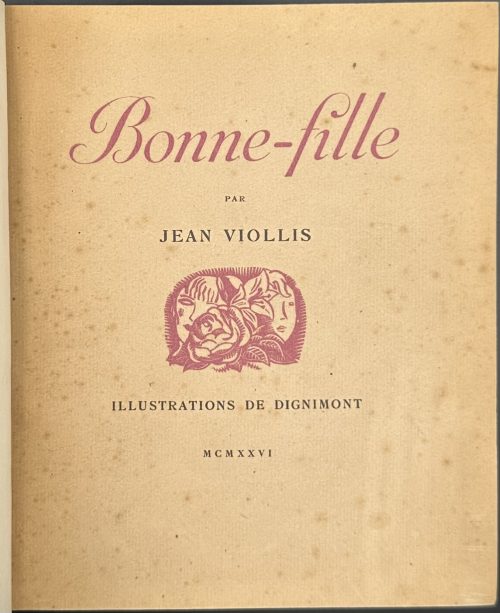 Hardcover volume, 22.5 x 19.5 cm, collated 4to, owner’s terracotta cloth with gilt-lettered black label to spine, publisher’s wrappers preserved, pp.:3 ffl, front wrapper, 3 ffl, [2] h.t./limit, [2] t.p./blank, 1-228 [2] 3 ffl, back wrapper, 3 ffl. Collation: π3 1-314 323. (130 leaves, incl. plates). Title-page (pink and black): Bonne-fille | PAR | JEAN VIOLLIS | Illustrations de | DIGNIMONT | {vignette} | A PARIS | La Collection Originale | ÉDITIONS MORNAY | 37, BOULEVARD DU MONTPARNASSE | MCMXXVI || Illustrations: 14 full-page colour plates, incl. frontispiece and endpiece, within collation but not within pagination, verso blank, and numerous head- and tailpieces and in-text stencil-coloured (au pochoir) lithography after André Dignimont. Limitation: A print run of 628 copies for sale, of which 18 on Japon Ancien, 30 on Japon Impérial, 90 on Hollande, 490 on Rives (139-628), plus 50 copies not for sale. Printed on May 12, 1926, at l’Imprimerie Kapp (Vanves), this copy is № 380. Provenance: Feodor Rojankovsky, pictorial bookplate “ИЗ КНИГ РОЖАНКОВСКАГО” to front pastedown, ms inscription to front ffl2 top “TH. ROJANKOWSKY | 14 VIII 30” in block letters. One of the possible transliterations of Feodor Rojankovsky's name is Theodor Rojankowsky. Contributors: Jean-Henri d'Ardenne deTizac [JeanViollis] (French, 1877 – 1932) – author. André Dignimont (French, 1891 – 1965) – artist. Frédéric Emile Kapp (French, 1851-193?) – printer. Georges Mornay (French, 1876 – 1935) et Antoinette Mornay – pubishers. Feodor Rojankovsky [Rojan; Фёдор Степанович Рожанковский] (Russian-American, 1891 – 1970) – provenance.
Hardcover volume, 22.5 x 19.5 cm, collated 4to, owner’s terracotta cloth with gilt-lettered black label to spine, publisher’s wrappers preserved, pp.:3 ffl, front wrapper, 3 ffl, [2] h.t./limit, [2] t.p./blank, 1-228 [2] 3 ffl, back wrapper, 3 ffl. Collation: π3 1-314 323. (130 leaves, incl. plates). Title-page (pink and black): Bonne-fille | PAR | JEAN VIOLLIS | Illustrations de | DIGNIMONT | {vignette} | A PARIS | La Collection Originale | ÉDITIONS MORNAY | 37, BOULEVARD DU MONTPARNASSE | MCMXXVI || Illustrations: 14 full-page colour plates, incl. frontispiece and endpiece, within collation but not within pagination, verso blank, and numerous head- and tailpieces and in-text stencil-coloured (au pochoir) lithography after André Dignimont. Limitation: A print run of 628 copies for sale, of which 18 on Japon Ancien, 30 on Japon Impérial, 90 on Hollande, 490 on Rives (139-628), plus 50 copies not for sale. Printed on May 12, 1926, at l’Imprimerie Kapp (Vanves), this copy is № 380. Provenance: Feodor Rojankovsky, pictorial bookplate “ИЗ КНИГ РОЖАНКОВСКАГО” to front pastedown, ms inscription to front ffl2 top “TH. ROJANKOWSKY | 14 VIII 30” in block letters. One of the possible transliterations of Feodor Rojankovsky's name is Theodor Rojankowsky. Contributors: Jean-Henri d'Ardenne deTizac [JeanViollis] (French, 1877 – 1932) – author. André Dignimont (French, 1891 – 1965) – artist. Frédéric Emile Kapp (French, 1851-193?) – printer. Georges Mornay (French, 1876 – 1935) et Antoinette Mornay – pubishers. Feodor Rojankovsky [Rojan; Фёдор Степанович Рожанковский] (Russian-American, 1891 – 1970) – provenance. -
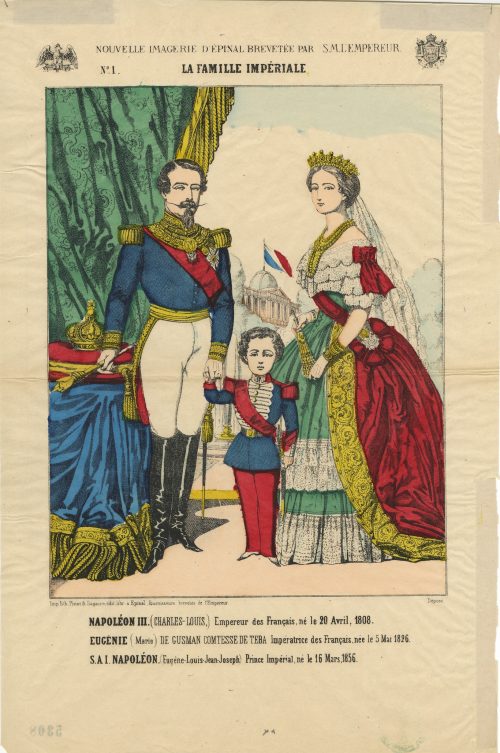 Hand-coloured woodcut on wove paper, 390 x 260 mm; black ink stamp “5308” to reverse; horizontal centerfold. Centre top: "NOUVELLE IMAGERIE D'ÉPINAL BREVETÉE PAR S.M.L’EMPEREUR" with imperial eagle and coat of arms at right and left. Below: "№ 1." — "LA FAMILLE IMPÉRIALE"; image in frame; under the image, left: "Imp lith. Pinot & Sagaire, édit. libr. à Épinal, fournisseurs brevetés de l’Empereur"; right: "Déposé". Bottom: "NAPOLÉON I. (CHARLES-LOUIS,) Empereur des Français, né le 20 Avril, 1808. | EUGÉNIE ( Marie) DE GUSMAN COMTESSE DE TEBA Impératrice des Français, née le 5 Mai 1826. | S.A I. NAPOLÉON. (Eugène-Louis-Jean-Joseph) Prince Impérial, ne le 16 Mars. 1856." Napoleon III [Charles-Louis Napoléon Bonaparte] (French, 1808 – 1873) Eugénie de Montijo [L'impératrice Eugénie] (Spanish-French, 1826 – 1920) Napoléon, Prince Imperial (Napoléon Eugène Louis Jean Joseph Bonaparte] (French, 1856 – 1879) Pinot & Sagaire (Épinal, 1861 – 1888) – enterprise, publisher/printer. Charles-François Pinot (French, 1817 – 1879) – publisher/printer.
Hand-coloured woodcut on wove paper, 390 x 260 mm; black ink stamp “5308” to reverse; horizontal centerfold. Centre top: "NOUVELLE IMAGERIE D'ÉPINAL BREVETÉE PAR S.M.L’EMPEREUR" with imperial eagle and coat of arms at right and left. Below: "№ 1." — "LA FAMILLE IMPÉRIALE"; image in frame; under the image, left: "Imp lith. Pinot & Sagaire, édit. libr. à Épinal, fournisseurs brevetés de l’Empereur"; right: "Déposé". Bottom: "NAPOLÉON I. (CHARLES-LOUIS,) Empereur des Français, né le 20 Avril, 1808. | EUGÉNIE ( Marie) DE GUSMAN COMTESSE DE TEBA Impératrice des Français, née le 5 Mai 1826. | S.A I. NAPOLÉON. (Eugène-Louis-Jean-Joseph) Prince Impérial, ne le 16 Mars. 1856." Napoleon III [Charles-Louis Napoléon Bonaparte] (French, 1808 – 1873) Eugénie de Montijo [L'impératrice Eugénie] (Spanish-French, 1826 – 1920) Napoléon, Prince Imperial (Napoléon Eugène Louis Jean Joseph Bonaparte] (French, 1856 – 1879) Pinot & Sagaire (Épinal, 1861 – 1888) – enterprise, publisher/printer. Charles-François Pinot (French, 1817 – 1879) – publisher/printer. -
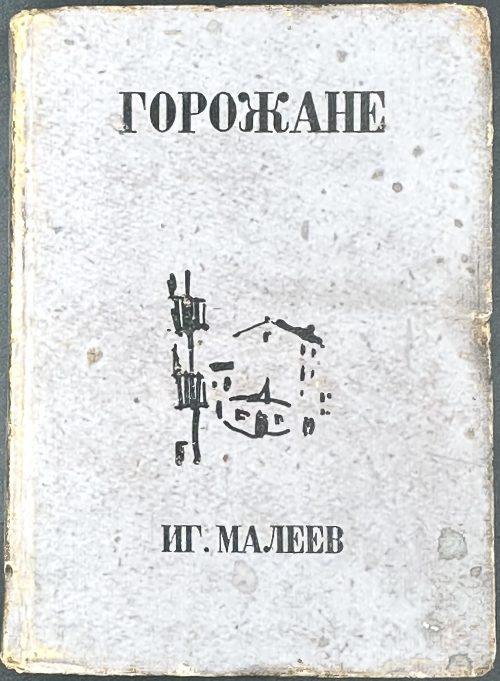 Hardcover volume, 17 x 12.5 cm, bound in lilac cardboard, lettering to covers and spine, vignette by Boris Rybchenkov to front board; pp.: [1-4] 5-188 [4]. Pencil ms to h.t. "Самалюк | Рай Кунцевское | Зав. роно" (Самалюк, зав. кунцевским районным отделом народного образования)ю Title-page: И. Г. МАЛЕЕВ | ГОРОЖАНЕ | МОСКОВСКОЕ | ТОВАРИЩЕСТВО | ПИСАТЕЛЕЙ || Print run: 5,200 copies. Contributors: Малеев, Игорь Александрович (Russian, 1904 – 1936?) – author. [Igor Maleyev] Рыбченков, Борис Федорович (Russian, 1899 – 1994) – artist. [Boris Rybchenkov]
Hardcover volume, 17 x 12.5 cm, bound in lilac cardboard, lettering to covers and spine, vignette by Boris Rybchenkov to front board; pp.: [1-4] 5-188 [4]. Pencil ms to h.t. "Самалюк | Рай Кунцевское | Зав. роно" (Самалюк, зав. кунцевским районным отделом народного образования)ю Title-page: И. Г. МАЛЕЕВ | ГОРОЖАНЕ | МОСКОВСКОЕ | ТОВАРИЩЕСТВО | ПИСАТЕЛЕЙ || Print run: 5,200 copies. Contributors: Малеев, Игорь Александрович (Russian, 1904 – 1936?) – author. [Igor Maleyev] Рыбченков, Борис Федорович (Russian, 1899 – 1994) – artist. [Boris Rybchenkov] -
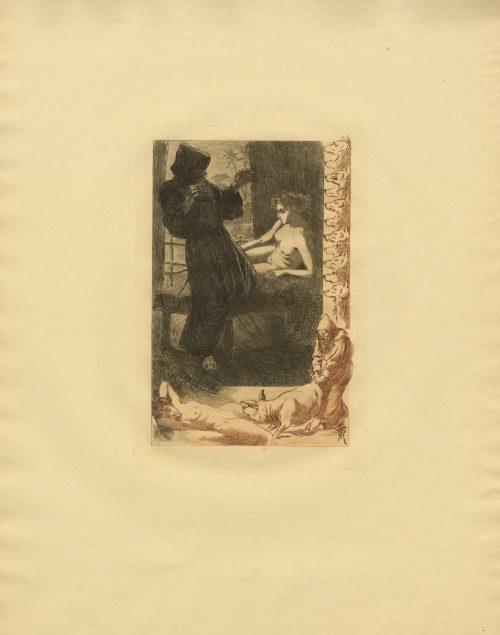 Set of 21 etchings by Martin van Maele for the English edition of ‘Thais’ by Anatole France published in London by Charles Carrington in 1901. Printed on vowe paper without a watermark in two colours with the black image and sepia historiated border. All etchings are inscribed with the artist's monogram; one of the etchings bears inscriptions ORGUEIL, LUXURE, DOUTE (mirror image). Dimensions: sheet: 317 x 250 mm; plate: 170 x 115 mm; image: 155 x 100 mm. Catalogue raisonné: S. A. Perry: № 64. Per Perry, the edition was printed in 500 copies on 'handmade paper watermarked 'Van Gelder'. Contributor: Martin van Maële [Martin, Maurice François Alfred] (French, 1863 – 1926)
Set of 21 etchings by Martin van Maele for the English edition of ‘Thais’ by Anatole France published in London by Charles Carrington in 1901. Printed on vowe paper without a watermark in two colours with the black image and sepia historiated border. All etchings are inscribed with the artist's monogram; one of the etchings bears inscriptions ORGUEIL, LUXURE, DOUTE (mirror image). Dimensions: sheet: 317 x 250 mm; plate: 170 x 115 mm; image: 155 x 100 mm. Catalogue raisonné: S. A. Perry: № 64. Per Perry, the edition was printed in 500 copies on 'handmade paper watermarked 'Van Gelder'. Contributor: Martin van Maële [Martin, Maurice François Alfred] (French, 1863 – 1926) -
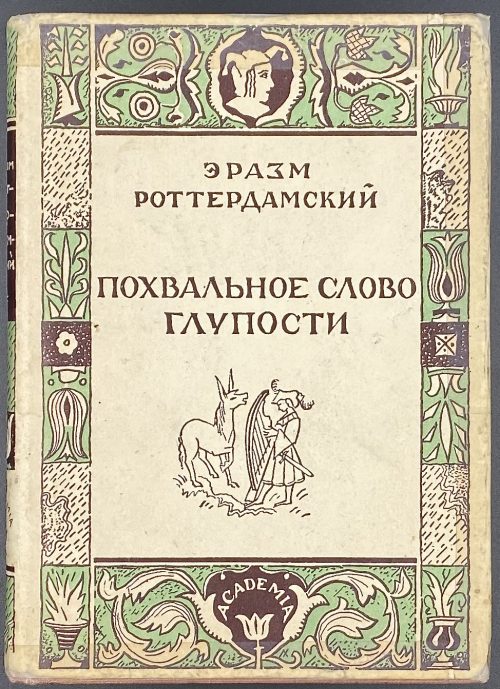
Title page [in black and blue]: ЭРАЗМ | РОТТЕРДАМСКИЙ | ПОХВАЛЬНОЕ СЛОВО | ГЛУПОСТИ | ПЕРЕВОД И КОММЕНТАРИИ | П. К. ГУБЕРА | ВСТУПИТЕЛЬНАЯ СТАТЬЯ | И. СМИЛГИ | {vignette} | ACADEMIA | МОСКВА ~ ЛЕНИНГРАД | 1932 ||
Pagination: [1-7] 8-236 [4], in-text illustrations after Hans Holbein the Younger, title page, DJ, cloth by Л. С. Хижинский, photo reproduction of the portrait of Erasmus by Hans Holbein the Younger from The Louvre museum w/guard paper.
Collation: 8vo; [1]8 2-158, + 1 plate extraneous to collation (portrait).
Binding: 18 x 13 cm; Pictorial stamped cloth, pictorial DJ, pictorial endpapers, back board blind-stamped.
Print run: 5,300 copies.
Catalogue raisonné: Крылов-Кичатова (2004), №477, p. 221. (in 1930 section). Contributors: Desiderius Erasmus Roterodamus (Dutch, c. 1469 – 1536) – author of the original text in Latin. Hans Holbein the Younger (German, 1497/8 – 1543) – artist. Губер, Пётр Константинович (Russian, 1886 – 1941) – translator from Latin into Russian (died in GULAG) Смилга, Ивар Тенисович (Latvian-Russian, 1892 – 1937) – author, foreword (shot by a firing squad). Хижинский, Леонид Семёнович (Russian, 1896 – 1972) – artist (title page, DJ, cloth). -
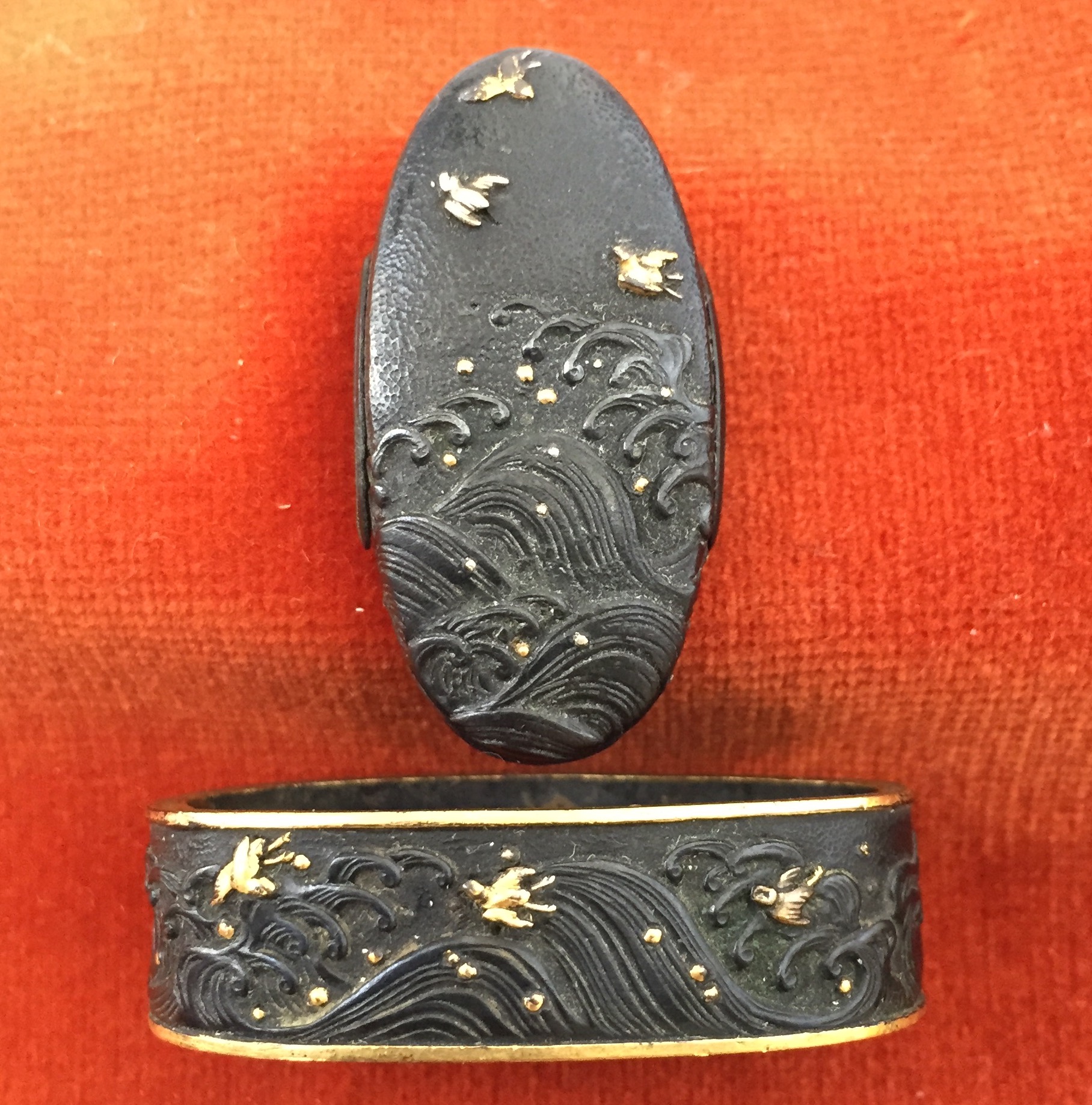 Fuchi: 37 x 21 x 11 mm; Weight: 13 g Kashira: 34 x 16 x 6 mm ; Weight: 10 g Material : Shakudo; Gold. Signature: Unsigned Technique: Sunameji Sukibori Zogan Decoration: Nami Chidori zu (wave & plover)
Fuchi: 37 x 21 x 11 mm; Weight: 13 g Kashira: 34 x 16 x 6 mm ; Weight: 10 g Material : Shakudo; Gold. Signature: Unsigned Technique: Sunameji Sukibori Zogan Decoration: Nami Chidori zu (wave & plover) -

NAPOLEON IN CARICATURE 1795-1821. By A. M. Broadley with an introductory essay on pictorial satire as a factor in napoleonic history by J. Holland Rose, Litt. D. Cantab. with nearly 250 illustrations, 24 in colour. Published by in London: John Lane, the Bodley Head, and New York: John Lane Company, 1911 in Two Volumes. Vol. I with 391 pages, 13 color plates and 99 full page illustrations. Vol. II with 441 pages, 11 color plates and 108 full page illustrations.
-
 Iron tsuba of round form with design of water plantain (omodaka) and wild goose in openwork (sukashi). Slightly rounded, square rim. Copper sekigane. Kyo school. Late Muromachi period: Early 16th century (Tenbun era) [Sasano's attribution]. Height: 76.2 mm. Width: 75.8 mm. Rim thickness: 5.3 mm. Center thickness: 4.5 mm. Provenance: Sasano Masayuki Collection, № 68: "The water plantain (omodaka) first appeared as a design for sword fittings in the Heian period. From such early beginnings, this decorative plant has shared a long history with the samurai. Also known as shogun's grass (shogununso), it was held in high esteem as a symbol of victory". The same tsuba was found at Japanese Swords and Tsuba from the Professor A. Z. Freeman and the Phyllis Sharpe Memorial collections. Sotheby's, London, Thursday 10 April 1997, page 22, item 60, saying that this is a "Kyo-sukashi tsuba, early to middle Edo period (late 17th/18th century) [Sotheby's attribution], and that it represents "a small bird among omodaka and aoi plants".
Iron tsuba of round form with design of water plantain (omodaka) and wild goose in openwork (sukashi). Slightly rounded, square rim. Copper sekigane. Kyo school. Late Muromachi period: Early 16th century (Tenbun era) [Sasano's attribution]. Height: 76.2 mm. Width: 75.8 mm. Rim thickness: 5.3 mm. Center thickness: 4.5 mm. Provenance: Sasano Masayuki Collection, № 68: "The water plantain (omodaka) first appeared as a design for sword fittings in the Heian period. From such early beginnings, this decorative plant has shared a long history with the samurai. Also known as shogun's grass (shogununso), it was held in high esteem as a symbol of victory". The same tsuba was found at Japanese Swords and Tsuba from the Professor A. Z. Freeman and the Phyllis Sharpe Memorial collections. Sotheby's, London, Thursday 10 April 1997, page 22, item 60, saying that this is a "Kyo-sukashi tsuba, early to middle Edo period (late 17th/18th century) [Sotheby's attribution], and that it represents "a small bird among omodaka and aoi plants". -
 Six-lobed iron tsuba in a form of three ginkgo tree leaves (icho), separated with three small triangular openings (ko-sukashi). Leaves have raised rim and decorated with various family crests (mon) in low relief carving (sukidashi-bori). On obverse: bamboo stems and leaves, knotted geese, paulownia (kiri), plum blossom (ume), and ivy. On reverse: pine needles and cone, maple leaf (kaede), bamboo, stylized plum blossom, and Genji-mon. Black patina. Kozuka hitsu-ana is original, with raised rim. Copper sekigane. Kamakura-bori school. Late Muromachi period (ca. 1550). Size: Height: 81.1 mm. Width: 90.0 mm. Thickness at seppa-dai: 3.3 mm. Weight: 120.4 g.
Six-lobed iron tsuba in a form of three ginkgo tree leaves (icho), separated with three small triangular openings (ko-sukashi). Leaves have raised rim and decorated with various family crests (mon) in low relief carving (sukidashi-bori). On obverse: bamboo stems and leaves, knotted geese, paulownia (kiri), plum blossom (ume), and ivy. On reverse: pine needles and cone, maple leaf (kaede), bamboo, stylized plum blossom, and Genji-mon. Black patina. Kozuka hitsu-ana is original, with raised rim. Copper sekigane. Kamakura-bori school. Late Muromachi period (ca. 1550). Size: Height: 81.1 mm. Width: 90.0 mm. Thickness at seppa-dai: 3.3 mm. Weight: 120.4 g. -
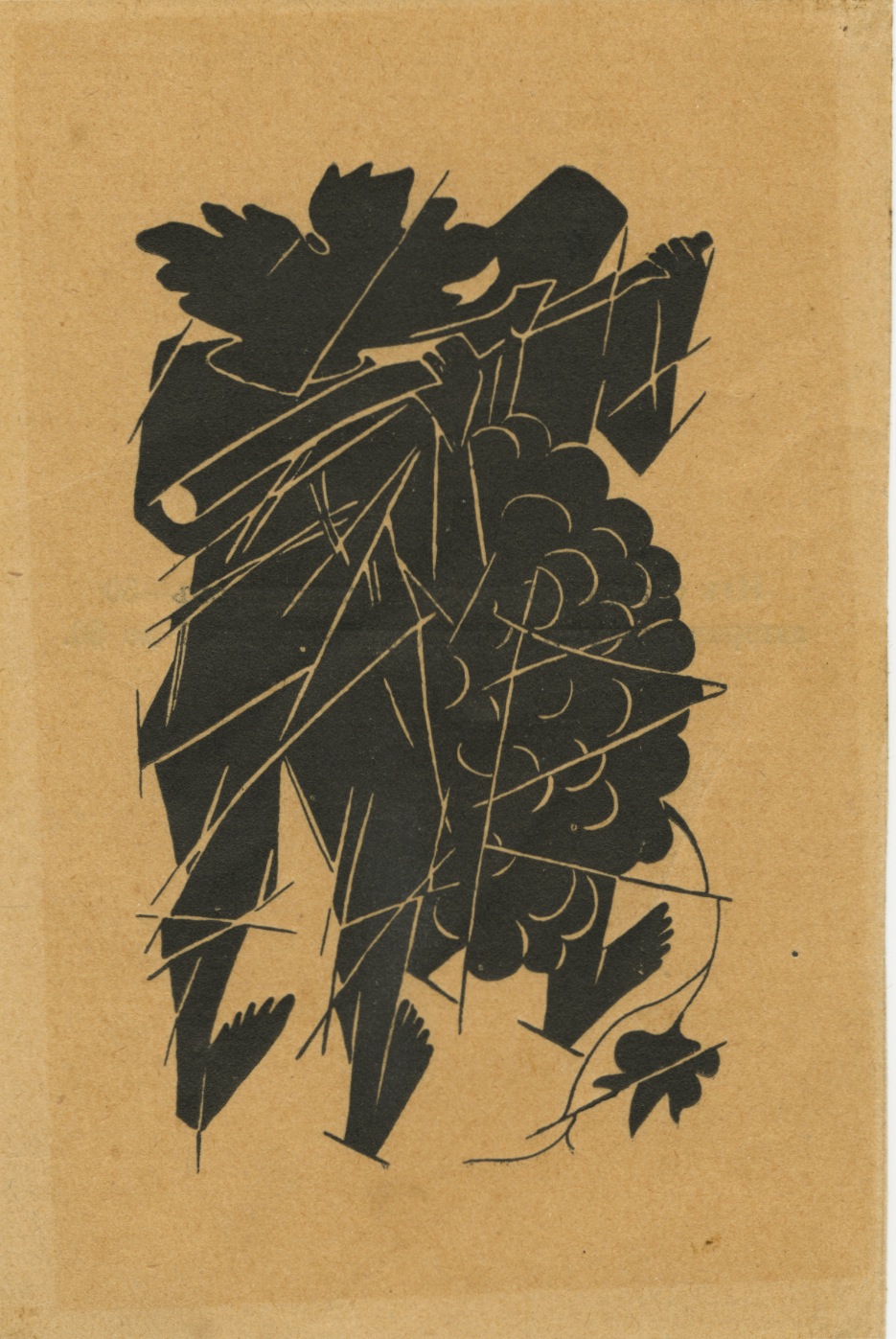 Artist: Natalia Goncharova (July 3, 1881 – October 17, 1962). Russian/French. Lithographic illustration (frontispiece) for Sergei Bobrov book of poetry "The gardeners upon the grapevines", Moscow, Lirika Publishers, 1913. Size: 18 х 11,5 cm.
Artist: Natalia Goncharova (July 3, 1881 – October 17, 1962). Russian/French. Lithographic illustration (frontispiece) for Sergei Bobrov book of poetry "The gardeners upon the grapevines", Moscow, Lirika Publishers, 1913. Size: 18 х 11,5 cm.Book was printed on May 20, 1913 for Lirika Publishers, by V. I. Voronov printshop in 500 copies, of them 50 authored and numbered. 10 lithographs by Natalia Goncharova printed at Kushneryov & Co. lithography in Moscow.
Наталия Гончарова (3 июля 1881 – 17 октября 1962). Россия/Франция. Литографическая иллюстрация (фронтиспис) к книге С. П. Боброва "Вертоградари над лозами" [Сергей Бобров. М.: /Лирика, 1913]. Формат: 18 х 11,5 см.Тираж 500 экз, из них 50 авторизованных и нумерованных. Десять цветных рисунков работы Н. Гончаровой исполнены в технике литографии на отдельных листах. Книга отпечатана 20 мая 1913 года в типографии В.И. Воронова для книгоиздательства «Лирика». В мягкой издательской обложке. На с. 162 после списка литографий: Отпечатаны литографией т-ва И.Н. Кушнерев и К° в Москве.
-

A yamagane tsuba of oval form with green-ish black patina decorated in usuniku-bori carving and gold iroe with wisteria (fuji) motif plus nanako-ji ground on both sides. Kozuka-hitsu-ana possibly cut later.
Unsigned.
Momoyama or may be even Muromachi period. Dimensions: 70.0 x 61.2 x 5.0 (center) mm -

Iron tsuba of round form (tsurumaru) decorated with a design of crane and pines, or "nesting crane (sugomori-tsuru)" in openwork (sukashi). Details carved in kebori. Rounded rim.
Size: 74.7 x 69.8 x 4.8 mm.
Unsigned.
Edo period, ca. 17th century.
NBTHK Certificate № 463485. The certificate says it's a Higo School piece. The design was popular in both Akasaka and Higo schools. The Akasaka example: at Kodogu and tsuba. International collections not published in my books. (Toso Soran). Ph. D. Kazutaro Torigoye, 1978, p. 246: "Late Edo. Jiyūgata. Sined: Akasaka Tadanori saku."The Higo example can be found at Iron tsuba. The works of the exhibition "Kurogane no hana", The Japanese Sword Museum, 2014, p. 69, №56: Sugomori-tsuru sukashi-tsuba (Nesting Carne). Mumei: Matashichi (1st generation), early 17th century.
Torigoye, 1978, p. 246. Late Akasaka.

Kurogane no hana, 2014, p. 69, №56. Higo tsuba.
-

Tsuba of oval form decorated with vines, tendrils, and leaves on trellis in brass inlay with details carved in kebori, and pierced with six family crests (mon) with two, three and four pointing stars in openwork, each outlined with brass wire and carved in kebori. Original hitsu-ana outlined with brass wire was probably enlarged later. Copper sekigane.
Momoyama to early Edo period (end of the 16th - beginning of the 17th century). Dimensions: 68.3 x 64.5 x 3.4 mm. -
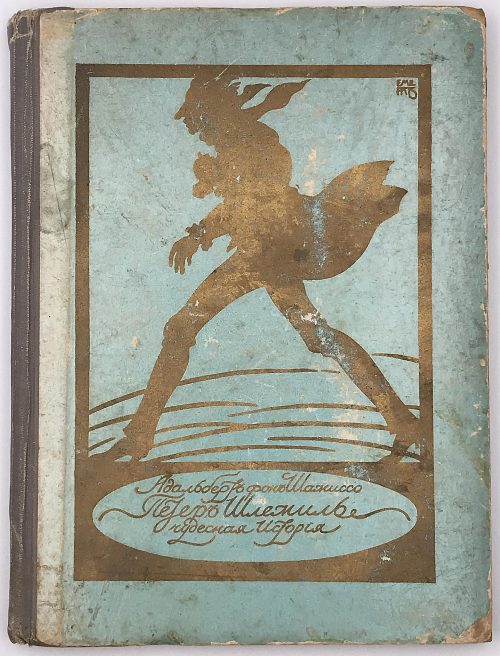
Шамиссо, Адальбертъ фонъ. Петеръ Шлемиль. Чудесная исторiя. Пер. П.Потемкина. Рис., виньетки и перепет Эмиля Преторiуса по 1-му нѣм. изд. 1814 г. — СПб.: Книгоиздательство "Пантеонъ", 1910. — 107 стр. Отпечатано в типографии акц. о-ва типографск. дела в СПБ (Герольд), 7 рота, 26.
Cardboard binding, 8vo, 20 x 15 cm. Russian translation of Adelbert von Chamisso book Peter Schlemihl, from the German by Peter Potemkine. With illustrations from 1814 original German first edition by Emil Preetorius. [SV: the latest statement seems strange as Emil Preetorius lived from 1883 to 1973]. -
 Utagawa Kunisada [歌川 国貞] a.k.a. Utagawa Toyokuni III [三代歌川豊国] (Japanese, 1786 – 1865)
Utagawa Kunisada [歌川 国貞] a.k.a. Utagawa Toyokuni III [三代歌川豊国] (Japanese, 1786 – 1865)Promotional fan for a hairpin shop, with a poem by Ichikawa Danjuro VII, signed Hakuen.
Date seal plus rectangular kiwame seal: Bunsei 8 (1825).
Size: Fan print. Uchiwa-e (27.5 x 21.1 cm) Publisher seal: Maru-To (2) (Marks U204). Date seal plus rectangular kiwame seal: Bunsei 8 (1825). -
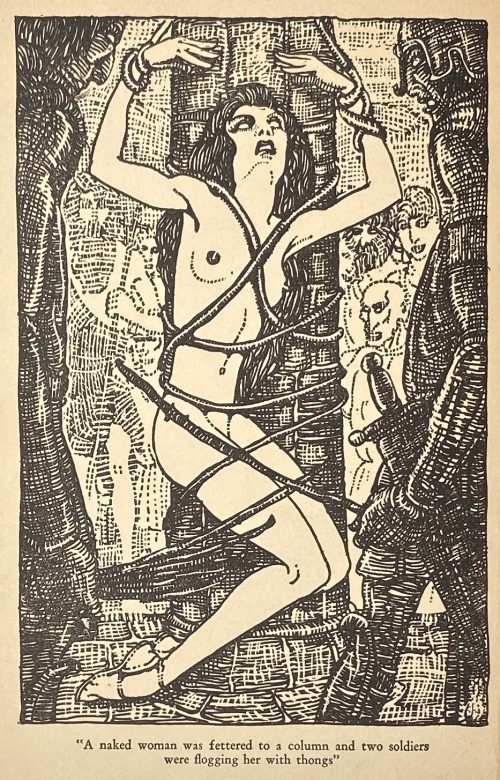 Title (in a frame): THE TEMPTATION | OF ST. ANTHONY | BY | GUSTAVE FLAUBERT | TRANSLATED BY | LAFCADIO HEARN | ILLUSTRATED BY | MAHLON BLAINE | {vignette} | NEW YORK | WILLIAMS, BELASCO | AND MEYERS || Pagination: ffl, [1, 2 - ht, blank] [2 - blank, frontis.] [3, 4 - t.p., colophon] [5, 6 - plate, blank] [7, 8 - list of ill., blank] [9 'argument'] 10-189 [190] bfl; frontispiece and 4 plates reproduced from Blaine's pen drawings in "woodcut" manner. Binding:25.5 x 17 cm., original black cloth, front cover and spine stamped in gilt; printed on thick paper, margins trimmed unevenly; pink pictorial DJ. Contributors: Gustave Flaubert (French, 1821 – 1880) – author. Mahlon Blaine (American, 1894 – 1969) – artist. Patrick Lafcadio Hearn [Koizumi Yakumo; 小泉 八雲] ( Greek-Irish, 1850 – 1904) – translator. Williams, Belasco and Meyers – publisher. J. J. Little & Ives, Co., NY – printer.
Title (in a frame): THE TEMPTATION | OF ST. ANTHONY | BY | GUSTAVE FLAUBERT | TRANSLATED BY | LAFCADIO HEARN | ILLUSTRATED BY | MAHLON BLAINE | {vignette} | NEW YORK | WILLIAMS, BELASCO | AND MEYERS || Pagination: ffl, [1, 2 - ht, blank] [2 - blank, frontis.] [3, 4 - t.p., colophon] [5, 6 - plate, blank] [7, 8 - list of ill., blank] [9 'argument'] 10-189 [190] bfl; frontispiece and 4 plates reproduced from Blaine's pen drawings in "woodcut" manner. Binding:25.5 x 17 cm., original black cloth, front cover and spine stamped in gilt; printed on thick paper, margins trimmed unevenly; pink pictorial DJ. Contributors: Gustave Flaubert (French, 1821 – 1880) – author. Mahlon Blaine (American, 1894 – 1969) – artist. Patrick Lafcadio Hearn [Koizumi Yakumo; 小泉 八雲] ( Greek-Irish, 1850 – 1904) – translator. Williams, Belasco and Meyers – publisher. J. J. Little & Ives, Co., NY – printer. -
 Uncut fan print (uchiwa-e) with the design of kabuki actor Nakamura Utaemon IV who held the name of Nakamura Shikan II from the 11th lunar month of 1825 to the 12th lunar month of 1835, dressed in a checkered kimono, holding a pipe and surrounded by flying fireflies. Character: Nakamura Utaemon IV [中村歌右衛門] (Japanese, 1796 – 1852); other names: Nakamura Shikan II, Nakamura Tsurusuke I, Nakamura Tōtarō. Series title: Catching fireflies in the floating world [浮世蛍狩] (Ukiyo hotarugari). Artist: Utagawa Kunisada [歌川 国貞], a.k.a. Toyokuni III (Japanese, 1786 – 1865). Signed: Kōchōrō Kunisada ga [香蝶楼国貞画] in a red cartouche. Publisher: Ibaya Kyubei [伊場屋 久兵衛] (Japanese, fl. 1804 – 1851); seal: modified Marks 19-009 | 126d. Censor's seal: Kiwame Date seal: Tenpō 2 (1831). Ref: Kunisada.de, N58. A look-alike yearlier Kunisada's design can be found at kunisada.de, ref. # N120-Z0172-410:
Uncut fan print (uchiwa-e) with the design of kabuki actor Nakamura Utaemon IV who held the name of Nakamura Shikan II from the 11th lunar month of 1825 to the 12th lunar month of 1835, dressed in a checkered kimono, holding a pipe and surrounded by flying fireflies. Character: Nakamura Utaemon IV [中村歌右衛門] (Japanese, 1796 – 1852); other names: Nakamura Shikan II, Nakamura Tsurusuke I, Nakamura Tōtarō. Series title: Catching fireflies in the floating world [浮世蛍狩] (Ukiyo hotarugari). Artist: Utagawa Kunisada [歌川 国貞], a.k.a. Toyokuni III (Japanese, 1786 – 1865). Signed: Kōchōrō Kunisada ga [香蝶楼国貞画] in a red cartouche. Publisher: Ibaya Kyubei [伊場屋 久兵衛] (Japanese, fl. 1804 – 1851); seal: modified Marks 19-009 | 126d. Censor's seal: Kiwame Date seal: Tenpō 2 (1831). Ref: Kunisada.de, N58. A look-alike yearlier Kunisada's design can be found at kunisada.de, ref. # N120-Z0172-410:
Actor Onoe Baikō, artist Kunisada, publisher Ibaya Kyūbei, c. 1820.
-
![George Cruikshank. George Cruikshank's Fairy Library. Hop-O'-My Thumb. Jack and the Bean-Stalk. Cinderella. Puss in Boots. — London: George Bell and Sons, 1885. — pp.: [2] blank, [2] first half-title with blank verso, [i-ii] second half-title with blank verso, [2] frontispiece plate with blank recto, [iii-viii] title, colophone, editor's note, list of illustr. [2] title with blank verso, [1] 2-101 [3] blank, 24 plates with protective tissue, unpag. — Colophon: This edition is limited to 500 copies, with India paper impressions. The former editions have been from lithographic transfers. The plates were retouched under Mr. Cruikshank's direction shortly before his death, and have not been used since until now.](https://varshavskycollection.com/wp-content/uploads/2021/02/LIB-2454.2020-f-1-500x659.jpeg) Title: GEORGE CRUIKSHANK'S FAIRY LIBRARY. | HOP-O'-MY THUMB. | JACK AND THE BEAN-STALK. | CINDERELLA. | PUSS IN BOOTS. | [DEVICE] | LONDON: | GEORGE BELL AND SONS, YORK STREET, COVENT GARDEN. Pagination: [2] – blanks, [2] – first half-title with blank verso, [i-ii] – second half-title with blank verso, [2] – blank / frontispiece, [iii-viii] title, colophon, editor's note, list of illustrations, [2] – title with blank verso, [1] 2-101 [3] – blank; 24 plates with protective tissue. Colophon: This edition is limited to 500 copies, with India paper impressions. The former editions have been from lithographic transfers. The plates were retouched under Mr. Cruikshank's direction shortly before his death, and have not been used since until now. Binding: 4to, 22.2 x 17.5 cm, hardcover; 3/4 black calf ruled in gilt, brown calf spine with raised bands decorated in gilt, with gilt title lettering. Green marbled boards and end-papers. Abel E. Berland's bookplate pasted to front pastedown. Professionally rebound, re-backed with the original spine laid down, corners bumped. Catalogue Raisonné: Not in Alan M. Cohen's. As writes the British Library: "George Cruikshank’s [...] illustrations for the first English translation of Grimm’s Fairy Tales were praised widely, but his own rewriting of fairytales was criticised, most prominently by Charles Dickens. This was not due to the quality of the illustrations, but because, in line with his temperance beliefs, Cruikshank rewrote aspects of the fairytales to warn the reader against the evils of alcohol. Thus, for instance, the preparations for Cinderella’s marriage include the court throwing all alcohol in the palace on a bonfire; and in ‘Jack and the Beanstalk’, the giant is an alcoholic. Dickens, a friend of Cruikshank, was outraged at what he considered to be a betrayal of the essence of fairytales and, in protest, he published an essay in his weekly magazine Household Words entitled ‘Frauds on the Fairies’ in protest (1853)."
Title: GEORGE CRUIKSHANK'S FAIRY LIBRARY. | HOP-O'-MY THUMB. | JACK AND THE BEAN-STALK. | CINDERELLA. | PUSS IN BOOTS. | [DEVICE] | LONDON: | GEORGE BELL AND SONS, YORK STREET, COVENT GARDEN. Pagination: [2] – blanks, [2] – first half-title with blank verso, [i-ii] – second half-title with blank verso, [2] – blank / frontispiece, [iii-viii] title, colophon, editor's note, list of illustrations, [2] – title with blank verso, [1] 2-101 [3] – blank; 24 plates with protective tissue. Colophon: This edition is limited to 500 copies, with India paper impressions. The former editions have been from lithographic transfers. The plates were retouched under Mr. Cruikshank's direction shortly before his death, and have not been used since until now. Binding: 4to, 22.2 x 17.5 cm, hardcover; 3/4 black calf ruled in gilt, brown calf spine with raised bands decorated in gilt, with gilt title lettering. Green marbled boards and end-papers. Abel E. Berland's bookplate pasted to front pastedown. Professionally rebound, re-backed with the original spine laid down, corners bumped. Catalogue Raisonné: Not in Alan M. Cohen's. As writes the British Library: "George Cruikshank’s [...] illustrations for the first English translation of Grimm’s Fairy Tales were praised widely, but his own rewriting of fairytales was criticised, most prominently by Charles Dickens. This was not due to the quality of the illustrations, but because, in line with his temperance beliefs, Cruikshank rewrote aspects of the fairytales to warn the reader against the evils of alcohol. Thus, for instance, the preparations for Cinderella’s marriage include the court throwing all alcohol in the palace on a bonfire; and in ‘Jack and the Beanstalk’, the giant is an alcoholic. Dickens, a friend of Cruikshank, was outraged at what he considered to be a betrayal of the essence of fairytales and, in protest, he published an essay in his weekly magazine Household Words entitled ‘Frauds on the Fairies’ in protest (1853)." -
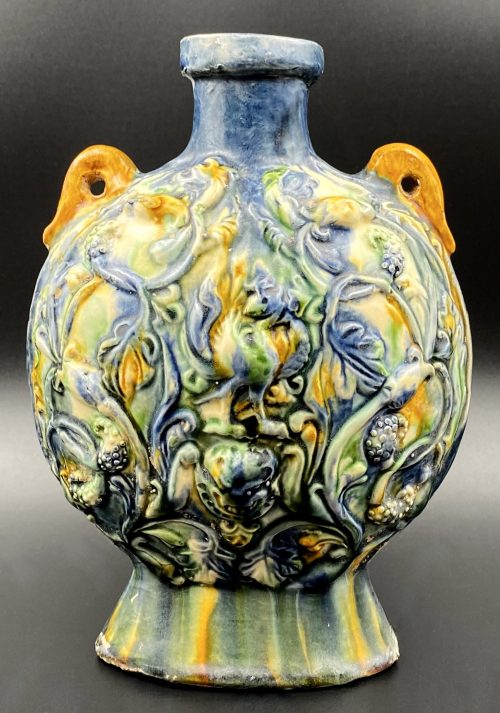 A vessel of flattened ovoid form supported on a tall splayed foot and surmounted by a short neck with the galleried rim. The shoulders set with a pair of loop handles, the body moulded on both sides with a Phenix surrounded with meandering floral and foliate scrolls. Covered with irregular splashes of green, amber, cream, and blue glazes, dripping down the foot. Foot bottom unglazed (beige body). China, the Tang dynasty [唐朝] (618 – 907). Height: 18.5 cm; Width: 13 cm
A vessel of flattened ovoid form supported on a tall splayed foot and surmounted by a short neck with the galleried rim. The shoulders set with a pair of loop handles, the body moulded on both sides with a Phenix surrounded with meandering floral and foliate scrolls. Covered with irregular splashes of green, amber, cream, and blue glazes, dripping down the foot. Foot bottom unglazed (beige body). China, the Tang dynasty [唐朝] (618 – 907). Height: 18.5 cm; Width: 13 cm -
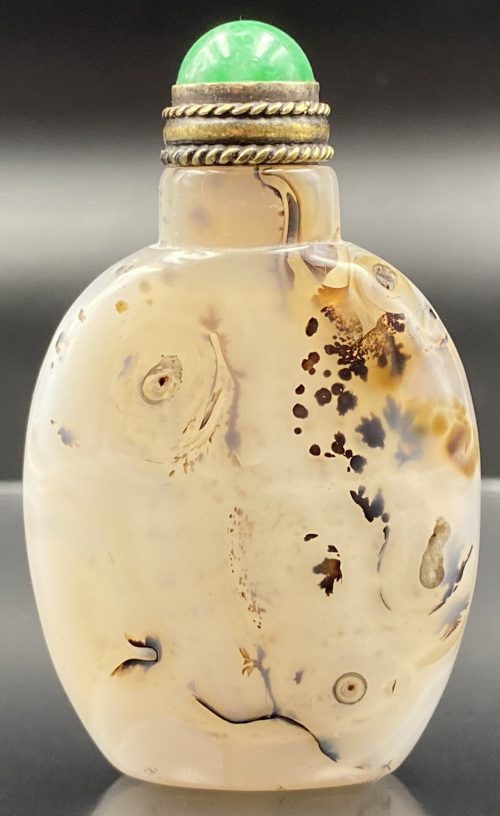 Agate snuff bottle of flattened rounded rectangular form, round neck, and flat base, semitransparent milky white body with dark brown inclusions of geometric form. Green jadeite stopper with a copper alloy spoon and collar. Qing dynasty [清] (1644-1912) Size: 7.2 x 4.3 x 2.2 cm
Agate snuff bottle of flattened rounded rectangular form, round neck, and flat base, semitransparent milky white body with dark brown inclusions of geometric form. Green jadeite stopper with a copper alloy spoon and collar. Qing dynasty [清] (1644-1912) Size: 7.2 x 4.3 x 2.2 cm -
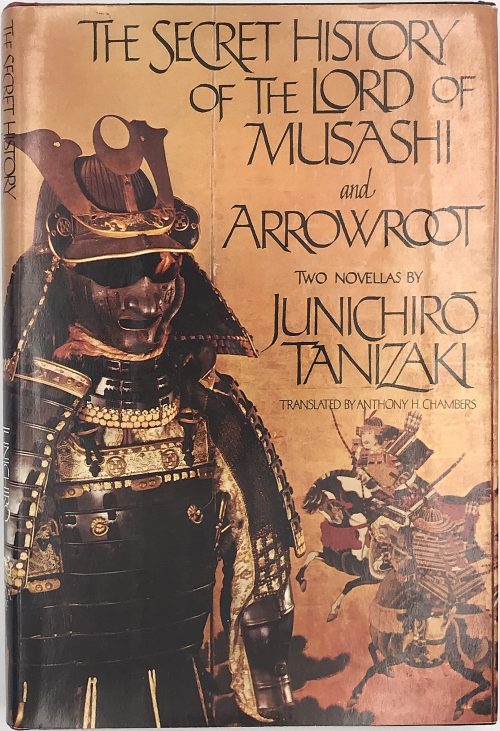 Hardcover, 22 x 15 cm; publisher's quarter burgundy cloth, gilt lettering to cover and spine, pictorial DJ. Stated 1st edition. Translation of Bushōkō Hiwa (The Secret History of the Lord of Musashi) and Yoshino Kuzu (Arrowroot). ISBN: 9780394524542
Hardcover, 22 x 15 cm; publisher's quarter burgundy cloth, gilt lettering to cover and spine, pictorial DJ. Stated 1st edition. Translation of Bushōkō Hiwa (The Secret History of the Lord of Musashi) and Yoshino Kuzu (Arrowroot). ISBN: 9780394524542


